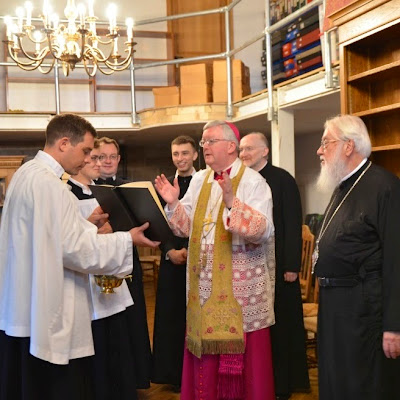The blessing of reliquaries begins with the versicles “Our help is in the name of the Lord.” and the following exhortation.
Let us pray, dearly beloved, God the Father almighty, that He who created all things in great goodness through His only-begotten Son in the power of the Holy Spirit, may deign to mercifully pour out upon us, though we are unworthy, the dew of his grace, for the consecration of these vessels prepared for the keeping of the relics of His Saints.This is followed by the long conclusion, (“Through the same our Lord…”), which segues into the preface dialogue, and the following preface.
Truly it is fitting and just… eternal God, God inestimable and ineffable, God of mercies and of all consolation. Who commanded Thy servant Moses to build an ark of incorruptible woods, according to the model which Thou didst show him on the mountain, and enclose it in purest gold, in which the golden urn filled with heavenly manna, with the tables of the covenant written by the finger of Thy majesty, might be preserved as a witness under future generations. And in our age, Thou hast made manifest these same things that they might be understood in a more sacred manner, since Thou has filled with all the fullness of divinity the body of Thy only Son, conceived of the incorrupt Virgin by the work of the Holy Spirit, and made to live by a rational soul.This preface is printed without music; it ends with the long conclusion, which is said in a low voice. The bishop then says “The Lord be with you,” and the following prayer.
We humbly implore Thee, almighty God, Father of our Lord Jesus Christ, from whom all paternity in heaven and earth is named; that Thou deign to imbue with Thy heavenly + blessing these vessels prepared for the pledges of thy Saints, as the same Saints intercede for us. And so may those that seek their patronage merit through their intercession to overcome, by Thy aid, all adversity, and merit also to find by the abundance of Thy bounty all things convenient and profitable.
* And as they, o Lord, by Thy inspiration, have been able to guard against the subtleties of spiritual wickednesses, and not only to despise, but also, since Christ the Lord did strengthen them, entirely to overcome the exquisite torments devised by men: so to those that venerate their merits, and humbly embrace their relics, being conciliated by the prayers of the same Thy saints, propitiously stretch Thou forth the right hand of Thy invincible power, against the devil and his angels, against lightnings and tempests, against hail, and various plagues, against foul air, and pestilences of men and beasts, against thieves and robbers, and the incursion of (enemy) nations, against savage beasts, and all the divers forms of serpents and reptiles, against the wicked inventions of bad men; to drive away what is hurtful, and always and everywhere to bestow what is profitable. *
Let us pray. Lord God almighty, * who, that Thou might restrain the murmuring of the mad people, and prove that the priesthood of Aaron was pleasing to thee, didst make his withered rod to bud and produce fruit-bearing flowers; and didst command it to be laid up in the ark of the covenant, for a sign of Thy power, and Who to us also hast shown, by the same presage, that Christ, who was withered on the altar of the Cross, bloometh afresh by His resurrection on the third day, and in this latter time through His death beareth fruit day and night in the raising up of the Church; we ask Thee, O most indulgent provider of the human race, * (we humbly beseech Thee) that Thou wouldst so sanctify, with Thy freely-given grace, these vessels prepared to receive Thy Saints; so that wheresoever they shall be carried forth in Thy name, Thou may drive away and annul all things adverse, through the interceding merits of them that dwell within, and multiply and preserve all things useful; so that Thy faithful may, through the greatness, or rather the universality of Thy kindnesses, rejoice that in a small portion of their relics, they have obtain the entire bodies of Thy Saints (i.e. the fruit of the final resurrection), and through the temporal places devoted to their prayers, be enlived with greater confidence to take possession with them of eternal joys. (long conclusion)He then sprinkles the reliquary with holy water.
In the revision of 1961, the first prayer, (“Let us pray, dearly beloved...”) is suppressed , and the second prayer (“Lord God almighty, who, that Thou might restrain...”) is moved into its place. The words noted within this prayer between the red stars are omitted. The words in parenthesis (“suppliciter exoramus - we humbly beseech Thee”) are added. Within the preface, the words noted between the red stars are omitted. The Sign of the Cross is not made at the words “heavenly blessing.” The preface is set to music; it ends with the long conclusion, which is sung as part of it, rather than said in a low voice. The bishop then sprinkles the reliquary with holy water.
 | |
| A silver reliquary of the 6th century from the Italian city of Grado, believed to be one of the oldest reliquaries in existence. |
10,000!









































































